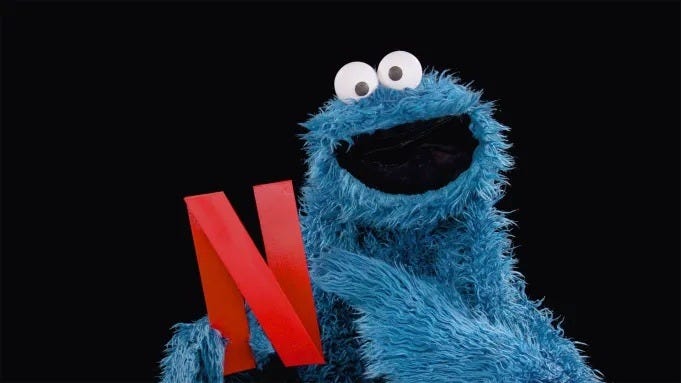Breaking Down the Sesame Street x Netflix Deal
A closer look at how the partnership could reshape kids' media through multi-platform access, interactive play, and kid-first design.
Big news broke yesterday: Sesame Street is getting a new streaming home on Netflix!
This deal is more than a lifeline for the beloved series. It has the potential to be a case study in how streamers can strategically approach IP, play, and access, and how we might reimagine the future of kids’ media distribution altogether.
Let’s break it down:
🍿 Same-Day Release on PBS and Netflix.
Let’s start with the main story.
Starting with Season 56, new episodes of Sesame Street will air on both Netflix and PBS Kids on the same day. It’s a shift from the previous model, where HBO held a 9-month exclusivity window before episodes became available on PBS.
And it’s worth paying attention to. In kids and family content, exclusivity doesn’t matter as much as access does. The broader the reach, the more likely kids are to actually encounter (and engage with) the content.
In today’s increasingly fragmented media landscape, casting a wide net is both harder and more essential than ever.
Now, do I really think same-day release on PBS is make-or-break for a 2–4-year-old audience? Probably not.
Which raises the question: Would Netflix agree to this kind of shared window for any other property? Or is Sesame Street the exception and this decision is in direct response to the current funding threats facing PBS?
I hope it’s not just a timely one-off decision. If this model proves successful, it could signal a potential shift in how kids’ content is distributed, one that prioritizes reach, equity, and impact over exclusivity.
🎮 The Real Win for Netflix? Play.
While the spotlight’s on the Sesame Street episodes, the real opportunity of the partnership is the games.
In addition to distributing the series, Netflix announced they will be able to develop video games for both Sesame Street and it’s spin off series Sesame Street Mecha Builders.
Their press release makes it clear: they’re not just excited to be acquiring the show, they’re thrilled to be gaining access to one of the most expansive and beloved character universes in kids’ media.
They specifically call out The World of Peppa Pig in their announcement of the partnership, which they’ve been buzzing about recently as a model for how preschool IP can drive sustained engagement through interactive games. By mentioning Peppa while announcing this deal, it may be a clue of their future plans: their goal of interactivity isn’t just bonus content for their series, it’s another potential destination for kids on their platform.
Access to the Sesame Street IP is a massive opportunity for Netflix to build out their preschool gaming presence - and arguably, the most forward-looking part of the partnership.
This deal gives Netflix a chance to build out its kids’ games library (a clear priority for them) using one of the largest and most recognizable character ensembles there is. It’s a rare opportunity to combine strategic growth with a brand that already has trust, familiarity, and emotional resonance with kids and families.
🧪 A Test Lab for Kids UX Design
If I were at Netflix, I’d be most excited about the opportunity to use the Sesame Street library as a testing ground for reimagining how kids’ content is packaged and delivered.
Right now, most streaming platforms are built around a structure of seasons, episodes, and continuity, a model inherited from adult programming. But that framework simply doesn’t reflect how we know preschoolers engage with media.
“Seasons” mean very little to a 3-year-old. They don’t care what episode number they’re on. Sometimes they’re seeking comfort and repetition. Sometimes they’re exploring something new.
This is where Sesame Street becomes an incredibly powerful asset. The library spans decades of flexible, modular content - segments, shorts, songs, recurring formats; it’s built to be remixed and repackaged in meaningful ways.
Netflix, thanks to its platform power, data infrastructure, and expanding kids’ portfolio, is uniquely positioned to use the newly acquired Sesame Street library to experiment and lead the way in creating a truly kid-first streaming experience.
If done well, Netflix could set a new UX standard - one that (finally) puts kids’ needs at the center of how kids content is presented.
And if they crack that model, it won’t just reshape their own platform; it could push the rest of the industry to start designing and distributing with kids in mind from the beginning.
👀 Final Thoughts
While it’s the top headline, this deal is about more than saving Sesame Street. From innovative distribution models, to game-based engagement, to kid-first design thinking, if taken full advantage of, this partnership could lead the way towards a more accessible, more playful, and more intentional future for children’s media.
There’s a lot packed into this partnership. Which part excites you most?
👋 Before You Go...
If you found this article interesting, please like, comment, share, or re-stack! It helps connect us to more creators, educators, and curious minds!
Working on something for kids and families? Let’s connect! I’m open for freelance and consulting work. I help teams develop original kids’ series, build character-driven worlds, and bring stories to life across TV, digital, and emerging platforms. Learn more about my work and reach out to collaborate here 👉: www.julietmenz.com
If you have thoughts, ideas, or feedback on this newsletter, hit reply or DM me @kidsmediabookclub here or on IG. I’d love to hear from you!
These thoughts are entirely my own. Everything shared is a reaction based on publicly available information and not informed by any internal knowledge or conversations I was privy to during my time at Sesame Workshop.






I love the idea of platforms like Netflix being more inventive with how they deliver kids content! Here's hoping Sesame Street starts something